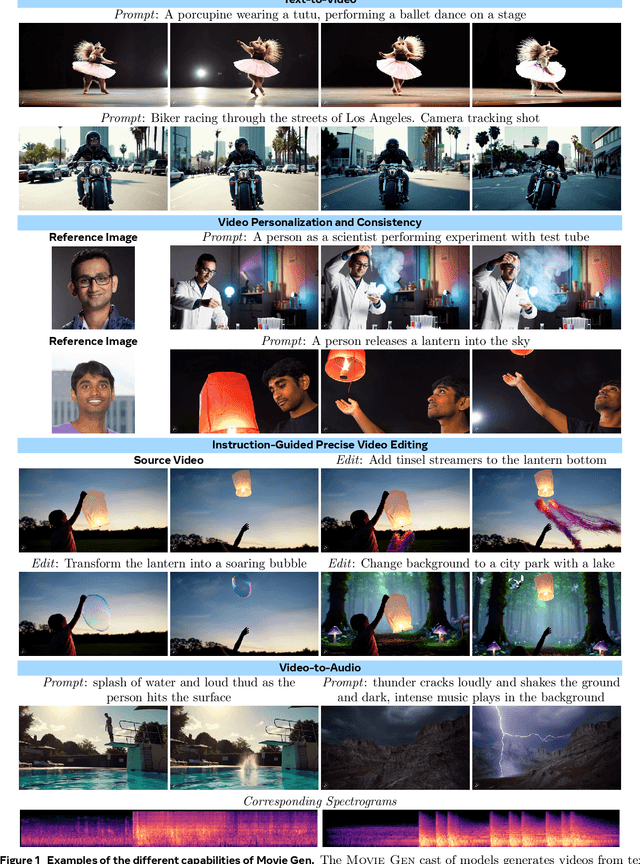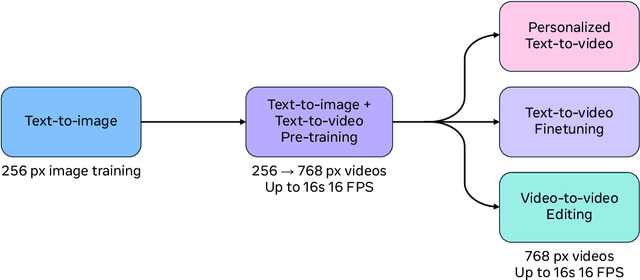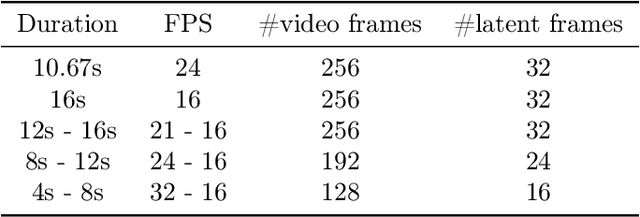Zijian He
VTON 360: High-Fidelity Virtual Try-On from Any Viewing Direction
Mar 15, 2025Abstract:Virtual Try-On (VTON) is a transformative technology in e-commerce and fashion design, enabling realistic digital visualization of clothing on individuals. In this work, we propose VTON 360, a novel 3D VTON method that addresses the open challenge of achieving high-fidelity VTON that supports any-view rendering. Specifically, we leverage the equivalence between a 3D model and its rendered multi-view 2D images, and reformulate 3D VTON as an extension of 2D VTON that ensures 3D consistent results across multiple views. To achieve this, we extend 2D VTON models to include multi-view garments and clothing-agnostic human body images as input, and propose several novel techniques to enhance them, including: i) a pseudo-3D pose representation using normal maps derived from the SMPL-X 3D human model, ii) a multi-view spatial attention mechanism that models the correlations between features from different viewing angles, and iii) a multi-view CLIP embedding that enhances the garment CLIP features used in 2D VTON with camera information. Extensive experiments on large-scale real datasets and clothing images from e-commerce platforms demonstrate the effectiveness of our approach. Project page: https://scnuhealthy.github.io/VTON360.
Cognify: Supercharging Gen-AI Workflows With Hierarchical Autotuning
Feb 12, 2025Abstract:Today's gen-AI workflows that involve multiple ML model calls, tool/API calls, data retrieval, or generic code execution are often tuned manually in an ad-hoc way that is both time-consuming and error-prone. In this paper, we propose a systematic approach for automatically tuning gen-AI workflows. Our key insight is that gen-AI workflows can benefit from structure, operator, and prompt changes, but unique properties of gen-AI workflows require new optimization techniques. We propose AdaSeek, an adaptive hierarchical search algorithm for autotuning gen-AI workflows. AdaSeek organizes workflow tuning methods into different layers based on the user-specified total search budget and distributes the budget across different layers based on the complexity of each layer. During its hierarchical search, AdaSeek redistributes the search budget from less useful to more promising tuning configurations based on workflow-level evaluation results. We implement AdaSeek in a workflow autotuning framework called Cognify and evaluate Cognify using six types of workflows such as RAG-based QA and text-to-SQL transformation. Overall, Cognify improves these workflows' generation quality by up to 2.8x, reduces execution monetary cost by up to 10x, and reduces end-to-end latency by 2.7x.
Comprehensive Performance Evaluation of YOLOv11, YOLOv10, YOLOv9, YOLOv8 and YOLOv5 on Object Detection of Power Equipment
Nov 28, 2024Abstract:With the rapid development of global industrial production, the demand for reliability in power equipment has been continuously increasing. Ensuring the stability of power system operations requires accurate methods to detect potential faults in power equipment, thereby guaranteeing the normal supply of electrical energy. In this article, the performance of YOLOv5, YOLOv8, YOLOv9, YOLOv10, and the state-of-the-art YOLOv11 methods was comprehensively evaluated for power equipment object detection. Experimental results demonstrate that the mean average precision (mAP) on a public dataset for power equipment was 54.4%, 55.5%, 43.8%, 48.0%, and 57.2%, respectively, with the YOLOv11 achieving the highest detection performance. Moreover, the YOLOv11 outperformed other methods in terms of recall rate and exhibited superior performance in reducing false detections. In conclusion, the findings indicate that the YOLOv11 model provides a reliable and effective solution for power equipment object detection, representing a promising approach to enhancing the operational reliability of power systems.
Movie Gen: A Cast of Media Foundation Models
Oct 17, 2024



Abstract:We present Movie Gen, a cast of foundation models that generates high-quality, 1080p HD videos with different aspect ratios and synchronized audio. We also show additional capabilities such as precise instruction-based video editing and generation of personalized videos based on a user's image. Our models set a new state-of-the-art on multiple tasks: text-to-video synthesis, video personalization, video editing, video-to-audio generation, and text-to-audio generation. Our largest video generation model is a 30B parameter transformer trained with a maximum context length of 73K video tokens, corresponding to a generated video of 16 seconds at 16 frames-per-second. We show multiple technical innovations and simplifications on the architecture, latent spaces, training objectives and recipes, data curation, evaluation protocols, parallelization techniques, and inference optimizations that allow us to reap the benefits of scaling pre-training data, model size, and training compute for training large scale media generation models. We hope this paper helps the research community to accelerate progress and innovation in media generation models. All videos from this paper are available at https://go.fb.me/MovieGenResearchVideos.
Pixel-Space Post-Training of Latent Diffusion Models
Sep 26, 2024



Abstract:Latent diffusion models (LDMs) have made significant advancements in the field of image generation in recent years. One major advantage of LDMs is their ability to operate in a compressed latent space, allowing for more efficient training and deployment. However, despite these advantages, challenges with LDMs still remain. For example, it has been observed that LDMs often generate high-frequency details and complex compositions imperfectly. We hypothesize that one reason for these flaws is due to the fact that all pre- and post-training of LDMs are done in latent space, which is typically $8 \times 8$ lower spatial-resolution than the output images. To address this issue, we propose adding pixel-space supervision in the post-training process to better preserve high-frequency details. Experimentally, we show that adding a pixel-space objective significantly improves both supervised quality fine-tuning and preference-based post-training by a large margin on a state-of-the-art DiT transformer and U-Net diffusion models in both visual quality and visual flaw metrics, while maintaining the same text alignment quality.
Time-Varying Foot-Placement Control for Underactuated Humanoid Walking on Swaying Rigid Surfaces
Sep 12, 2024Abstract:Locomotion on dynamic rigid surface (i.e., rigid surface accelerating in an inertial frame) presents complex challenges for controller design, which are essential for deploying humanoid robots in dynamic real-world environments such as moving trains, ships, and airplanes. This paper introduces a real-time, provably stabilizing control approach for underactuated humanoid walking on periodically swaying rigid surface. The first key contribution is the analytical extension of the classical angular momentum-based linear inverted pendulum model from static to swaying grounds. This extension results in a time-varying, nonhomogeneous robot model, which is fundamentally different from the existing pendulum models. We synthesize a discrete footstep control law for the model and derive a new set of sufficient stability conditions that verify the controller's stabilizing effect. Another key contribution is the development of a hierarchical control framework that incorporates the proposed footstep control law as its higher-layer planner to ensure the stability of underactuated walking. The closed-loop stability of the complete hybrid, full-order robot dynamics under this control framework is provably analyzed based on nonlinear control theory. Finally, experiments conducted on a Digit humanoid robot, both in simulations and with hardware, demonstrate the framework's effectiveness in addressing underactuated bipedal locomotion on swaying ground, even in the presence of uncertain surface motions and unknown external pushes.
WildVidFit: Video Virtual Try-On in the Wild via Image-Based Controlled Diffusion Models
Jul 15, 2024Abstract:Video virtual try-on aims to generate realistic sequences that maintain garment identity and adapt to a person's pose and body shape in source videos. Traditional image-based methods, relying on warping and blending, struggle with complex human movements and occlusions, limiting their effectiveness in video try-on applications. Moreover, video-based models require extensive, high-quality data and substantial computational resources. To tackle these issues, we reconceptualize video try-on as a process of generating videos conditioned on garment descriptions and human motion. Our solution, WildVidFit, employs image-based controlled diffusion models for a streamlined, one-stage approach. This model, conditioned on specific garments and individuals, is trained on still images rather than videos. It leverages diffusion guidance from pre-trained models including a video masked autoencoder for segment smoothness improvement and a self-supervised model for feature alignment of adjacent frame in the latent space. This integration markedly boosts the model's ability to maintain temporal coherence, enabling more effective video try-on within an image-based framework. Our experiments on the VITON-HD and DressCode datasets, along with tests on the VVT and TikTok datasets, demonstrate WildVidFit's capability to generate fluid and coherent videos. The project page website is at wildvidfit-project.github.io.
AnimateZoo: Zero-shot Video Generation of Cross-Species Animation via Subject Alignment
Apr 07, 2024Abstract:Recent video editing advancements rely on accurate pose sequences to animate subjects. However, these efforts are not suitable for cross-species animation due to pose misalignment between species (for example, the poses of a cat differs greatly from that of a pig due to differences in body structure). In this paper, we present AnimateZoo, a zero-shot diffusion-based video generator to address this challenging cross-species animation issue, aiming to accurately produce animal animations while preserving the background. The key technique used in our AnimateZoo is subject alignment, which includes two steps. First, we improve appearance feature extraction by integrating a Laplacian detail booster and a prompt-tuning identity extractor. These components are specifically designed to capture essential appearance information, including identity and fine details. Second, we align shape features and address conflicts from differing subjects by introducing a scale-information remover. This ensures accurate cross-species animation. Moreover, we introduce two high-quality animal video datasets featuring a wide variety of species. Trained on these extensive datasets, our model is capable of generating videos characterized by accurate movements, consistent appearance, and high-fidelity frames, without the need for the pre-inference fine-tuning that prior arts required. Extensive experiments showcase the outstanding performance of our method in cross-species action following tasks, demonstrating exceptional shape adaptation capability. The project page is available at https://justinxu0.github.io/AnimateZoo/.
Legged Robot State Estimation within Non-inertial Environments
Mar 24, 2024Abstract:This paper investigates the robot state estimation problem within a non-inertial environment. The proposed state estimation approach relaxes the common assumption of static ground in the system modeling. The process and measurement models explicitly treat the movement of the non-inertial environments without requiring knowledge of its motion in the inertial frame or relying on GPS or sensing environmental landmarks. Further, the proposed state estimator is formulated as an invariant extended Kalman filter (InEKF) with the deterministic part of its process model obeying the group-affine property, leading to log-linear error dynamics. The observability analysis of the filter confirms that the robot's pose (i.e., position and orientation) and velocity relative to the non-inertial environment are observable. Hardware experiments on a humanoid robot moving on a rotating and translating treadmill demonstrate the high convergence rate and accuracy of the proposed InEKF even under significant treadmill pitch sway, as well as large estimation errors.
APIServe: Efficient API Support for Large-Language Model Inferencing
Feb 02, 2024Abstract:Large language models are increasingly integrated with external tools and APIs like ChatGPT plugins to extend their capability beyond language-centric tasks. However, today's LLM inference systems are designed for standalone LLMs. They treat API calls as new requests, causing unnecessary recomputation of already computed contexts, which accounts for 37-40% of total model forwarding time. This paper presents APIServe, the first LLM inference framework targeting API-augmented LLMs. APISERVE minimizes the GPU resource waste caused by API calls and dedicates saved memory for serving more requests. APISERVE improves the overall serving throughput by 1.6x and completes 2x more requests per second compared to the state-of-the-art LLM inference systems.
 Add to Chrome
Add to Chrome Add to Firefox
Add to Firefox Add to Edge
Add to Edge